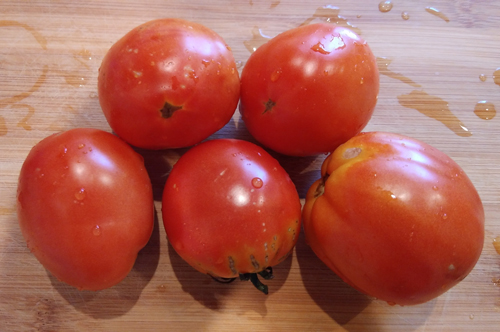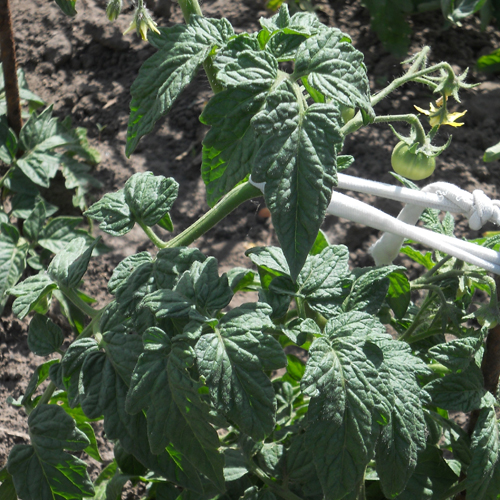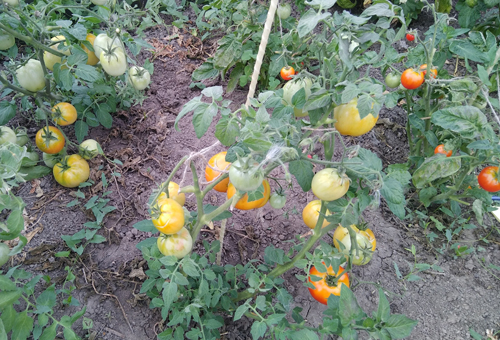Klusha tomato variety
Domestic breeders sometimes present real gifts to gardeners in the form of unpretentious and fruitful varieties. Among the tomato novelties, one cannot fail to mention Klusha. This is a young species, entered into the State Register of Breeding Achievements of Russia in 2009 with admission in all regions. Its applicants are well-known breeders Postnikova T.N. and Dederko V.N. The crop is recommended to be grown in open ground and under film shelters in personal subsidiary plots. The variety is not a hybrid, so you can harvest the seeds yourself. The tomato most likely got its unusual name because of its appearance. The fruits, like chickens, are reliably hidden inside the bush, so much so that you cannot see them at first glance. Reviews about the variety are very different, but, nevertheless, it arouses undisguised interest. Let's try to understand the strengths and weaknesses of the new product.

Description
The plant is determinate, undersized, self-limiting its growth after the formation of the apical fruit cluster, up to 50 cm high. The standard type provides Klushu with a strong, stable stem. The branching is weak, but the shoots are powerful, the foliage is good. Outwardly, the bush looks compact, leaves the impression of a powerful and resistant plant. Leaves of medium size, dark green, usual type, succulent, with a medium wrinkled surface. The flowers are light yellow, collected in a simple inflorescence. The fruit cluster is formed inside the bush and is reliably hidden under the leaf plates, so the hot midday sun does not threaten the tomatoes. 5 - 8 ovaries are formed in each fruit cluster. The peduncle of the variety is without articulation.
The fruits of Klushi are strong, round or flat-round in shape, sometimes with slightly pronounced ribbing. An unripe fruit is colored green, while a ripe fruit is poured into an even red color. The skin is dense, firm, shiny. Tomatoes are medium-sized, weighing about 150 grams, according to the State Register - 100 grams. Like most varieties of this culture, the largest fruits ripen on the first clusters, on subsequent ones the weight decreases slightly. The pulp is fleshy, at the break, sugary, watermelon type, not watery, low-seeded, without voids. There are 6 or more seed chambers. The State Register rates the taste of tomatoes as excellent, but some gardeners are ready to argue with this, evaluating the taste as ordinary, not outstanding.

Variety characteristics
- Klusha belongs to early ripening crops, ripening occurs 95 - 105 days after the emergence of full shoots;
- the yield from one bush is small - 1.5 - 2.5 kg. But taking into account the fact that a large number of plants can be planted per square meter, this figure increases. According to the State Register, the yield under film shelters is 3.5 kg per 1 sq. meters;
- the immunity of the tomato is average, but, according to reviews, the culture is not afraid of phytophthora, especially in the early stages of the growing season, it is resistant to top rot;
- the plant has a great adaptability, which allows gardeners in unfavorable regions (for example, Siberia) to grow the variety in the open field;
- the yield is stable, despite the heat or cold, the plant sets and gives off the crop;
- drought resistance is excellent;
- tomatoes do not crack even in rainy weather;
- the transportability and keeping quality of Klushi fruits, according to reviews, are at the level of firm 3. Therefore, it is advisable to send the harvested crop of this variety for processing;
- the way of eating fruits is universal. Early tomatoes are used for making salads, thanks to their dense structure and strong skin, excellent whole-fruit preservation is obtained from them. There are many positive reviews about the quality of the resulting tomato products, especially juice.

Agrotechnics
It is best to grow the species in seedlings. But some gardeners in warm regions sowed seeds directly into the soil. Seedlings are planted on seedlings 50-60 days before the intended planting in the ground. According to reviews, the seedlings are strong, stocky, do not stretch.But the germination of tomato seeds is poor. In the phase of 2 true leaves, the seedlings dive, 2 weeks before transplanting, they begin to harden. Due to their compactness, the plants can be placed in the garden quite densely - up to 8 bushes per 1 square meter in open ground. In the greenhouse, a little less often - up to 5 bushes for the same space. This planting density helps save space in small areas.
Klushu is called a variety for the lazy, since the culture requires minimal care. Thanks to the standard shape, no garter is needed. But during maturation, it is recommended to install supports under the brushes. But experienced gardeners here, too, made their task easier. During the formation of fruit clusters around the bush, they lay out a thick layer of straw. Thanks to this, the tomatoes lie on a soft substrate and do not come into contact with the soil. In addition, straw acts as a mulch, keeping moisture in the soil for a long time and inhibiting the growth of weeds. Leaving - it couldn't be easier. Watering is moderate, some gardeners, taking into account atmospheric precipitation, moisten the beds only 2 times per season. Top dressing can be used universal. To help tomatoes ripen more quickly and accumulate more sugars in cooler regions, it is recommended to remove the leaves so that the fruits receive more sunlight. But in the south, you do not need to harvest the leaves, thanks to them the crop will not be baked in the sun.
When growing Klushi in a greenhouse, the following recommendations must be followed:
- Monitor soil and air moisture. With an increase in these indicators, the yield of the variety decreases, favorable conditions are created for the development of fungal diseases.
- Control the air temperature. If the thermometer rises above 35 - 38 ° C, the pollination process stops, therefore, the formation of ovaries in tomatoes stops.
- In greenhouse conditions, plants must be treated with antifungal drugs, since a closed room is devoid of natural ventilation.
Taking advantage of the peculiarity of the variety - its small height and compactness, many tomato growers manage to grow this species without leaving home. It turns out that Klusha feels great in the role of a tub plant and looks quite decorative. Growing at home is not difficult. Agrotechnics are standard for all balcony types.
More recently, another variety with a similar name has appeared - Super-Klusha. He is also registered in the State Register. But this is a different variety - indeterminate, with larger fruits and a pink color.
Klusha is ideal for growing in central Russia. But tomato shows good results in other regions as well. An unpretentious plant does not require any effort on the part of the gardener during cultivation, therefore it is suitable for beginners mastering the basics of tomato growing. Productivity, thanks to a dense planting, is high. Tomatoes are great for various types of preservation and processing. Many owners of suburban areas who can visit their gardens only on weekends have appreciated this variety and are not going to abandon it in the future. Well, for lovers of exquisite tastes, there are many others, for example, pink-fruited varieties, which, by the way, include Super-Klusha.








